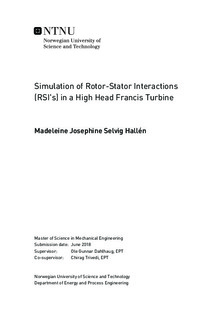Simulation of Rotor-Stator Interactions (RSI's) in a High Head Francis Turbine
Master thesis
Permanent lenke
http://hdl.handle.net/11250/2559707Utgivelsesdato
2018Metadata
Vis full innførselSamlinger
Sammendrag
As energy demand is growing along with the quest for green energy the operating range for hydropower is being pushed into non-favourable conditions. The unsteady flow regimes at these conditions lead to transient phenomenons like pressure oscillations that can propagate through the whole turbine, threatening the reliability of the turbine. It is therefore important to identify these pressure pulsations to ensure safe operation. This master thesis presents transient simulations of the Francis model turbine at the Waterpower Laboratory at NTNU for eleven different guide vane openings ranging from a 4-degree opening to a 14-degree opening. The software used for the simulations is ANSYS CFX 18.1, applying the SST turbulence model. The primary focus is Rotor-Stator Interactions (RSI's), hence the model has been simplified accordingly, limiting the computational domain to guide vanes, runner and part of the draft tube. The frequency spectrum for pressure fluctuations have been obtained at several monitor points in the domain through Fast Fourier Transformations (FFT) using MATLAB, and then compared to experimental values for validation. The frequencies for RSI's are quite accurately predicted and it is possible to identify the trends for the amplitudes when considering the pressure pulsations in a single point at different guide vane openings. However, comparing different points in the domain at the same guide vane opening does not yield the same trend for the amplitudes for the simulations and the experiments. It is believed that this is due to differences in mesh resolution for the guide vane domain and the runner domain, but further studies need to be conducted to test this hypothesis.
